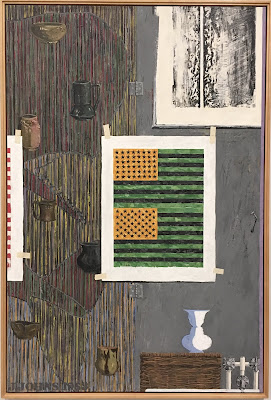Ventriloquist, 1983
Encaustic on canvas
190.2 x 127. 3
Bridge, 1997
Oil on canvas with objects
198.1 x 299.7 cm
The Critic Sees, 1961
Sculpt-metal on plaster with glass
7.9 x 16.5 x 5.4 cm
0 through 9, 1961
Oil on canvas
Dancers on a Plane, 1980
Oil on canvas with patinated bronze frame
200 x 161.9 cm
Celine, 1978
Oil on canvas (two panels)
215.9 x 122.6 cm
Field Painting, 1963-1964
Oil on canvas with objects (two panels)
182.9 x 93.2 cm
I went to see this exhibition twice, once with my family and once with a long-time friend and fellow Johns enthusiast. As with all shows of this magnitude, it's a lot to take in, not just once but twice. For what it's worth, doubling and the nuances of dualisms of all kinds are persistently present in Johns, especially as keyed by the marquis work, Painting with Two Balls. You be the judge. In fact, that does seem to be an important point to the work, a certain ambiguity, a certain lack of resolution, a certain mount of uncertainty, and therefore a resemblance of truth, whereby it actually may or may not be so, again dependent on the viewer, I think. Once more, you be the judge. Aside from whatever coy plays/ploys between language and phenomena, this body of work seems to revel and succeed in balancing both.



















No comments:
Post a Comment